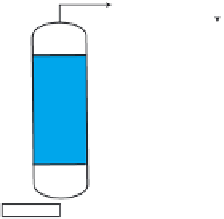Environmental Engineering Reference
In-Depth Information
Sweep gas
Adsorption
Regeneration
heat
N
2
Adsorption
Regeneration
Sweep gas
N
2
lower T
higher T
Normal P
Lower P
Flue gas
cool
Flue gas
CO
2
CO
2
CO
2
CO
2
40º C
40º C
T
final
T
final
p
CO
2
p
CO
2
0.14 atm
1.0 atm
0.07 atm
0.14 atm
CO
2
adsorption
CO
2
desorption
CO
2
desorption
CO
2
adsorption
(a)
(b)
Figure 6.2.3.
Temperature and pressure swing adsorption
(a) In
temperature swing adsorption
, we make use of differences in adsorption at dif-
ferent temperatures. The adsorption step is done at a lower temperature (1 atm,
40ºC, 14% CO
2
) compared to the desorption step. The isotherms give the equilib-
rium concentrations at adsorption and desorption conditions. The working capacity
is the amount of CO
2
that is removed in one cycle.
(b) In
pressure swing adsorption
, we make use of differences in adsorption at different
pressures. The adsorption step is done at a higher pressure (1 atm, 40ºC, 14% CO
2
)
compared to the desorption step. The isotherms give the equilibrium concentrations
at adsorption and desorption conditions. The working capacity is the amount of CO
2
that is removed in one cycle.
Question 6.2.1 Working capacity
Do the following changes of the operating conditions
decrease
or
increase
the working capacity?
1. Decrease the fl ue gas temperature.
2. Increase the fl ue gas pressure.
3. Decrease the pressure at desorption. (How would we do this in
practice?)





































Search WWH ::

Custom Search